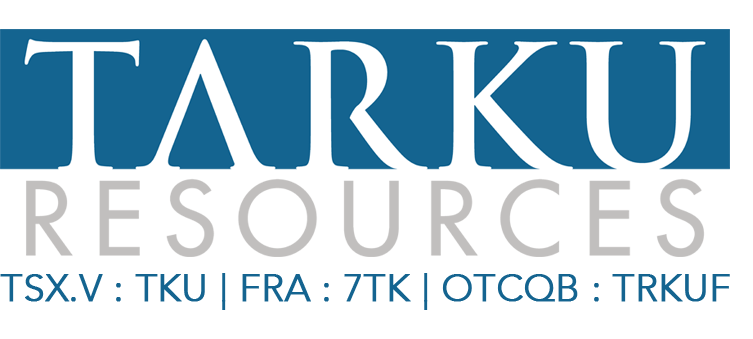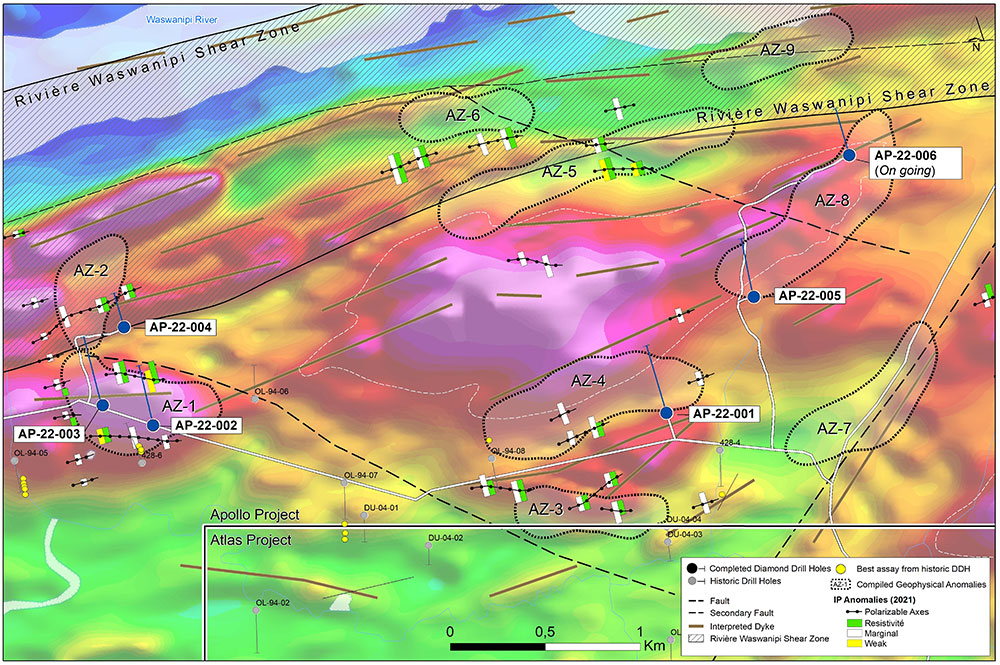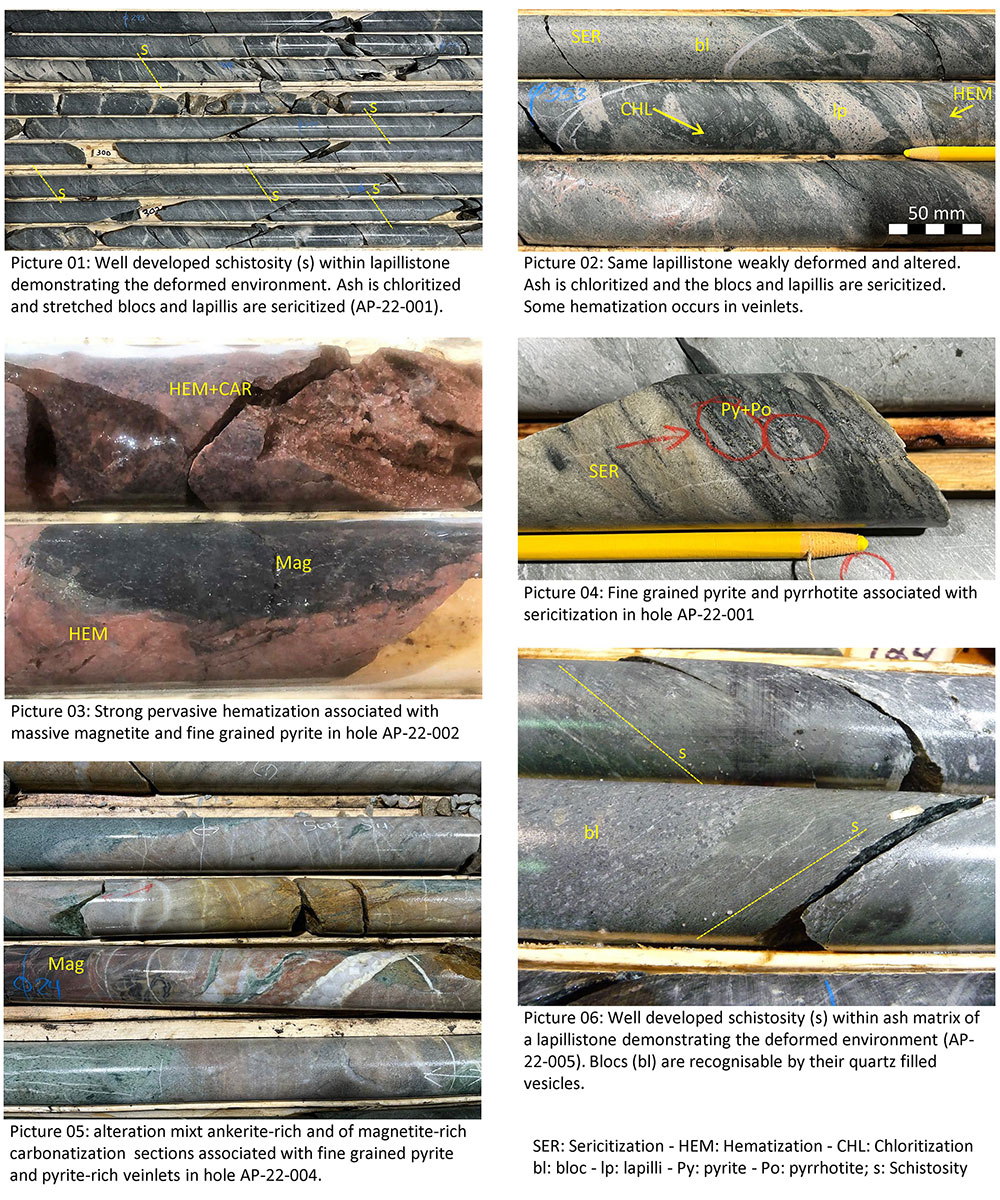Tarku notes the Presence of Orogenic Gold Deposit Style Alteration in its Ongoing Drilling at Apollo
![]() Download PDF version | View all documents on Sedar
Download PDF version | View all documents on Sedar
MONTREAL, November 24, 2022. Tarku Resources Ltd (TSX-V: TKU – FRA: 7TK – OTCQB: TRKUF) (the “Company” or “Tarku”) is pleased provide shareholders with an update on its ongoing drill program at the Apollo Gold Project, part of the 3As Projects, located in the Matagami area, Eeyou Istchee James Bay, Quebec. The drill program is more than half way through, and the Company is pleased with the geological environment encountered in each of the 5 holes. Assays are pending for all holes but are expected to be received during Q1 2023.
- Five (5) holes totalizing 1,739m completed to date, the sixth hole is underway.
- Visual inspection of the core reveals intensive hydrothermal alteration similar in style to Orogenic Gold Deposits, including; hematization, carbonatization and-sericitization.
- Fine grained disseminated pyrite and pyrrhotite are observed over 10 metres to 20 metres intervals.
- The drill core has now been prepared and sent for assay, with results expected in the first quarter of 2023.
Julien Davy, President and CEO of Tarku Resources said: “The completion of the first five holes at the Apollo Gold Project has revealed an extensive hydrothermal system within a strongly deformation corridor across the project area. The visual inspection of the core showed alteration types associated with visible sulfide mineralization within the core, typical of orogenic gold bearing systems and more specifically of iron-rich alkaline and calcitic metasomatic system, such as numerous gold deposit in the Abitibi region and the nearby Detour Lake Gold Mine. We eagerly await the assay results.”
Apollo Drill Program Summary
- The First Hole (AP-22-001, 408m depth) tested the Eastern edge of the Zone 4 Target (AZ4) corresponding to a high-chargeability anomaly, observed on the flank of a large magnetic anomaly suggesting the presence of mafic intrusion or a group of porphyritic dykes with an east-west orientation. The rocks are highly deformed with a strong schistosity (Picture 1). The hole intersected about 150m of strongly sericitized felsic volcanic tuffs, followed by intermediate to mafic volcanic ash to lapilli tuff sequences (Picture 2) with strong porphyry-style alteration transitioning from hematization-magnetitization to carbonatization-sericitization and strong silicification accompanied by an increase in alteration intensity with downhole depth. Up to 6% pyrite and potentially pyrrhotite (Picture 4) has been describe associated with the intensity of the carbonatization and hematization in places;
- The Second Hole (AP-22-002, 386m depth) tested the east side of the Zone 1 Target (AZ1) corresponding to an increasing chargeability associated with a decreasing resistivity and a strong magnetic anomaly. The hole intersected syenitic rocks toward the top of the hole and over 100m of pervasive carbonatization, silicification, and hematization associated with disseminated to massive magnetite (Picture 3) with up to 7% pyrite, and potentially pyrrhotite, both finely disseminated. In several meter-long sections, carbonate veinlets are also present with recrystalized pyrite, and potentially pyrrhotite (picture 04).
- The Third Hole (AP-22-003, 358m depth) also targeted the Zone 1 Target (AZ1) on its western margin corresponding to an increasing chargeability associated with a decreasing resistivity and a strong magnetic anomaly. The hole, which is 100m apart from AP-22-002, intersected similar very long strong pervasive alteration sequences with up to 7% pyrite and potentially pyrrhotite both finely disseminated and recrystalized associated with carbonate veinlets. Presence of magnetite veinlets associated with fine disseminated pyrite. Hole intersected about 8m of syenitic-type intrusion.
- The Fourth Hole (AP-22-004, 217m depth) tested the Zone 2 Target (AZ2), located about 250m north from Zone 1. The hole intersected more mafic units with 10m long strong porphyry-style alteration transitioning from quartz-carbonate-ankerite to hematization-magnetite associated with up to 5% pyrite very finely disseminated (Picture 5). Epidotization, as well as fuschite have been describe in the hole.
- The Fifth Hole (AP-22-005, 370m depth) tested the Western edge of the Zone 8 Target corresponding to a high chargeability followed with a strong magnetic susceptibility. Hole intersected same intermediate to mafic volcanic tuffs (Picture 6) weakly to moderately altered until the presence of several meter wide syenitic intrusions. The 100m wide section is strongly altered with pervasive silicification altering with moderate to intense meter wide sections of hematization associated with disseminated to massive magnetite and up to 5% disseminated pyrite. The hole section is regularly crosscut by quartz-carbonate and pyrite veinlets stockwork.
Location Map of the ongoing drill program at the Apollo Project. Background is a geophysical compilation of MAG, IP and TDEM surveys completed between 2019 and 2022
Pictures of the drill core demonstrating the strong deformation environment with strong alteration phases associated with mineralization
About the 3As project
The Apollo Project is part of the 100%-owned, 3 As projects (Apollo, Atlas, Admiral), and is located adjacent and to the north of the Atlas Project. It consists of 69 claims (3,775 ha, or 37.7 km2) centred on the Rivière Waswanipi Shear Zone (RWSZ). Collectively, the 3 As projects consists of 217 claims covering 130 km2 in prolific area.
The 3 As projects were acquire in 2016, as Tarku staked open ground, based on a detailed data compilation exercise in the region, this process also took into account the historical zinc mining district of Matagami (4.6 Mt Zn and 0.494 Mt Cu from 1960 to 2004) and the overlooked potential for gold mineralization.
These studies suggested that the regional shear zone was the eastern extension of the Sunday Lake Fault, which host’s the 15 Moz Au Detour Lake Mine and the Kirkland Lake Mining Camp, which historically produced over 50 million ounces of gold. Similar to the Sunday Lake Fault the RWSZ is characterized by the presence of alkaline rocks, polygenic conglomerates (Timiskaming type) and porphyry intrusions bearing anomalous gold values on the order of hundreds of parts per billion (GM 52712).
Along the same regional structure, other explorers, such as Maple Gold, Balmoral and Midland Exploration, have returned exciting drill results and demonstrated the strong gold potential of the area.
Qualified persons
Julien Davy, P.Geo., M.Sc, MBA, President and Chief Executive Officer of Tarku, the qualified person under National Instrument 43-101 Standards of Disclosure for Mineral Projects, prepared, supervised and approved the technical information in this news release.
About Tarku Resources Ltd. (TSX.V: TKU – FRA: 7TK – OTCBQ: TRKUF)
Tarku is an exploration company focused on new discoveries in favourable mining jurisdictions such as Quebec and Arizona.
In Arizona, within the famous Tombstone District, Tarku owns 100% of the 29 km2 Silver Strike Project. Silver Strike has been interpreted by management to have the protentional for similar CRD Deposits comparable to the Hermosa Project, located 80km west in Santa Cruz County, Arizona, which South32 acquired for USD 1.8 billion in 2018. Tarku is currently planning a surface mapping program, a deep-penetrating and high-resolution geophysical survey over the priority targets, with a minimum of 5,000-meter drill program in the upcoming month.
In Quebec, Tarku owns 100% of the “Three A’s” exploration projects, (Apollo, Admiral and Atlas Projects), in the Matagami Greenstone Belt, which has been interpreted by management as the eastern extension of the Detour Belt. The Detour Belt has seen recent exploration successes by Midland Exploration Inc., Wallbridge Mining Company Ltd., Probe Metals Inc. After the last deep-penetration and high-definition IP geophysical survey over Apollo, Tarku has started a drill program of a minimum of 3,000-meter.
On behalf of Tarku Resources Ltd
Julien Davy,
President and CEO
Tarku Contact Information:
Email:
Website: www.tarkuresources.com
Please follow @TarkuResources on LinkedIn, Facebook, Twitter and Instagram.
Neither TSX Venture Exchange nor its Regulation Services Provider (as that term is defined in the policies of the TSX Venture Exchange) accepts responsibility for the adequacy or accuracy of this release.
This press release may contain forward-looking statements that are subject to known and unknown risks and uncertainties that could cause actual results and activities to vary materially from targeted results and planning. Such risks and uncertainties include those described in Tarku’s periodic reports including the annual report or in the filings made by Tarku from time to time with securities regulatory authorities.


